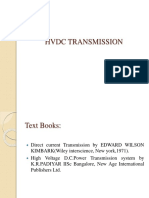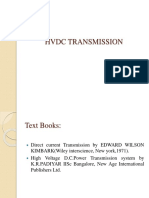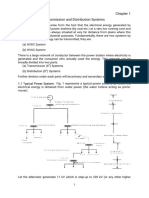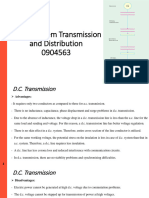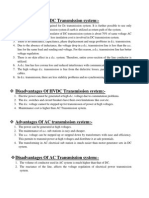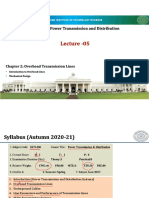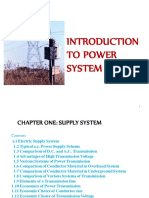Introduction –
Structure of Power System
Class:
Bachelor of Engineering in Electrical Engineering
Semester : Sixth Semester
Bikram Chhetri
Department of Electrical Engineering
College of Science and Technology
Royal University of Bhutan
2/15/2022
� Review of the last class
1. Power supply system definition and components
2. Power supply structure
3. Standard voltages for Generation, Transmission and distribution
4. Classification of Transmission system
Reference: Principles of Power System – V K Mehta
Power System Analysis and Design –B.R.Gupta
Electrical Power System-Wadhwa, C. L.
2/15/2022
� Learning Outcomes
It is expected to find answer to the following questions:
Transmission system classification
AC and DC transmission / distribution system
Why AC / DC transmission system?
Comparison of AC and DC Transmission system
Why UG / OH transmission / distribution?
Comparison of UG and OH transmission system
2/15/2022
� Classification of Transmission System
Transmission systems
AC Transmission system
1-phase
2-phase
3-phase
DC Transmission System
2-wire
3-wire
Why AC transmission or DC Transmission? When to adopt either one?
OH Transmission System
UG Transmission System
Why OH or UG Transmission? When to adopt either one?
Why high voltage power transmission? Why not at the generated or the
consumer voltage?
2/15/2022
� Classification of Transmission System
Transmission systems
AC Transmission system
DC Transmission System
Why AC transmission or DC Transmission? When to adopt either
one?
OH Transmission System
UG Transmission System
Why OH or UG Transmission? When to adopt either one?
Why high voltage power transmission? Why not at the generated
or the consumer voltage?
2/15/2022
� Comparison between AC and DC Transmission
Comparison between AC and DC Transmission System
https://circuitglobe.com/difference-between-ac-and-dc-transmission-
line.html
The transmission lined are categorized into three categories.
Short Transmission Line – The length of the short transmission line is
up to 80Km.
Medium Transmission Line – The length of the medium transmission
line lies between 80km to 200km.
Long transmission Line – The length of long transmission line is
greater than 150km.
The supports, conductor, insulator, cross arms and clamp, fuses and
isolating switches, phases plates etc. are the main component of the
transmission lines.
2/15/2022
� Comparison between AC and DC Transmission
2/15/2022
� Comparison between AC and DC Transmission
Advantages of DC Transmission
DC Transmission requires only 2 conductors
as compared to AC transmission which uses
3 conductors.
There is no inductance, capacitance, phase displacement and
surge problems in DC transmission.
Due to absence of inductance, the voltage drop in DC transmission
(V=IR) is less than the AC transmission (V=I(R+jX)) for same load.
Therefore, DC transmission has better voltage regulation.
There is no skin effect in the DC transmission and therefore entire
cross-section of the conductor is utilized.
2/15/2022
� Comparison between AC and DC Transmission
A DC line has less corona loss and improved efficiency and less
interference with communication system.
For the same voltage, the potential stress on the Insulators are less
in DC system as compared to AC system (because in AC the
Insulators have to bear peak voltage which is 1.414 times the RMS
voltage.)
A DC line requires less insulation for same working voltage, because
potential stress on the insulation is less in case of DC System.
In DC transmission, there is no stability and synchronization problem.
2/15/2022
� Comparison between AC and DC Transmission
Disadvantages of DC Transmission:
DC Power generation is difficult at high voltage due to commutation
problem.
Transformers does not work for DC and therefore DC Voltage cannot
be stepped up or stepped down.
DC Switches and Circuit Breakers have their own limitations.
2/15/2022
� Comparison between AC and DC Transmission
Advantages of AC Transmission:
1. AC power can be generated at high voltage. The maximum voltage at
which Electrical Power is generated is at 21 kV (in India).
2. AC voltage can be stepped up for power transmission at high voltage.
3. Maintenance of AC Substations is easy and Cheaper.
2/15/2022
� Comparison between AC and DC Transmission
Disadvantages of AC Transmission (ACT):
1. ACT requires more conductor material (copper) as compared to DC
transmission. Three phase AC transmission line requires atleast 3
conductors. Expensive.
2. The construction of ACT line is more complicated as compared to
DCT line.
3. In ACT skin effect increases effective resistance of line. More losses
and correspondingly decreases the efficiency of transmission.
4. Due to inductance and capacitance, the voltage drop in the AC line
(V = IZ) is more than the DC line (V=IR) for the same sending end
voltage and load. This makes the voltage regulation poor.
5. The ACT lines have more corona loss. Reduced efficiency of
transmission.
6. Interference in communication circuits.
2/15/2022
� Comparison between AC and DC Transmission
2/15/2022
� Comparison between AC and DC Transmission
CONCLUSION
From these comparison, we can see that DC transmission has many
advantages as compared to AC transmission.
Although at present, transmission of power is carried out by AC but
there is an increasing trend for DC transmission because of
advancement in Power Electronics.
2/15/2022
� Comparison between AC and DC Transmission
Comparison of various supply systems.
Table-1. Ratio of conductor materials in supply system compared with that in the
corresponding 2-wire dc system. VK Mehta Page 145.
2/15/2022
� Comparison between AC and DC Transmission
The following points can be noted from this comparison:
1. There is great saving in conductor materials if DC system is adopted
for transmission of electric power.
2. Considering the ac system, the 3-phase ac system is most suitable
for transmission due to two reasons. Firstly there is considerable
saving in conductor material. Secondly this system is convenient and
efficient.
2/15/2022
� Examples of world’s longest DC transmission lines:
https://www.power-technology.com
Belo Monte-Rio de Janeiro Xiangjiaba-Shanghai TRL, China
transmission line, Brazil 1980, 800kV , 7.2 GW, July 2010,
2,543km-long, 800kV (UHVDC), first UHVDC link
11.2GW, 2019.
Rio Madeira transmission link Inga-Kolwezi TRL, Congo
2385 km-long, 600kV (HVDC) bipolar 1700km, 500kV, 560 MW, 1982
line, 7.1GW of power, 2013.
Belo Monte-Estreito transmission line, Talcher-Kolar TRL, India
Brazil 1450 km, 500kV HVDC TRL,
2500 MW, February 2003
2,092 km, 800kV, 4 GW, 2017
Jinping-Sunan TRL, China
2,090 km, 800kV, 7.2 GW, Dec 2012
2/15/2022
� Comparison between OH and UG Transmission system
Overhead Transmission System (OHTS)
An OH power line is a structure used in electric power transmission and
distribution to transmit electrical energy across large distances. It
consists of one or more uninsulated conductors (commonly multiples of
three) suspended by towers or poles. OHTL uses bare conductors.
These conductors are placed at a height from the ground in the natural
atmosphere.
To maintain clearance between the conductors and ground, supporting
towers are used. The voltage of the TL decides the height of the tower.
The insulators are used to provide insulation between the conductor and
the tower.
With increase in transmission voltage level, the height of the tower
increases to provide more clearance between the ground and conductors.
2/15/2022
� Comparison between OH and UG Transmission system
Underground (UG) Transmission system.
UGTL are electrical cables that are installed beneath the ground. In the
UGTS, number of conductors are bunched together with proper
insulation.
The UG cable are provided with lead sheath and armoring to provide
protection against moisture and mechanical injury.
With increase in voltage level, the thickness of insulation increases.
2/15/2022
� Comparison between OH and UG Transmission system
A comparison between underground and overhead transmission cables:
http://engineering.electrical-equipment.org/others/comparison-overhead-underground-
transmission-cables.html
Basis of comparison:
1. Construction
UG cables are more expensive to construct since they have to be
electrically insulated and have to provide protection against moisture,
corrosion, mechanical damage and other environmental impacts from
the soil. Construction of the cables is more complicated compared to
the OH conductors.
OH conductors do not require insulation and sheathing. The OH cables
have lesser requirements and cheaper to construct.
2/15/2022
� Comparison between OH and UG Transmission system
2. Cost
An UG 230 kV line costs 10 to 15 times the cost of an OH line due to time,
materials, processes, the need to include transition substations and the use of
specialized labor.
3. Installation
The installation of OH lines on poles is easier and straightforward.
However, the UG cables require digging trenches and this may be complicated
by other utility service lines such as water pipes, oil and gas pipelines, sewer
lines. Other complications may arise due to rocks, loose soil and water along the
routes, making them more expensive to install.
. Heat dissipation
UG cables are installed in concrete encased PVC duct banks. Heat generated by
the cables is dissipated into the earth. Heat dissipation in UG cables is limited
by the layers of insulation and protection sheaths. Poor dissipation.
OH lines are air cooled and widely spaced for safety. Heat is released to the
surrounding and automatic natural cooling is provided by the air. Better
dissipation.
2/15/2022
� Comparison between OH and UG Transmission system
5. Size of Conductors
UG cables have larger conductor sizes compared to OH lines for the
same amount of power, as the OH lines have a natural cooling and
hence the ability to carry more power without heating up.
6. Voltage withstanding capacity
The OH lines are better suited to withstand higher voltages
compared to the UG cables, which are limited by the expensive
construction and limited heat dissipation. For these reasons, the UG
cables are mostly used for transmitting up to 33kV.
7. Fault detection and repair
Damage to OH lines is easy to locate and repair takes shorter time.
Damage to UG transmission lines is difficult to pinpoint and repairs
may take a few weeks to several months to complete.
2/15/2022
� Comparison between OH and UG Transmission system
8. Public safety
UG cables are safer to the public, animals and environment compared to the
OH lines.
The OH lines can be brought down by any natural calamities or ageing and
can have interventions with human, animal as well as weather and
vegetation.
The UG cables are less impacted by these conditions and not affected by
trees, animals, accidents, wind, storms and other physical interference.
9. Effect of lightning discharges
OH lines are more prone to lightning strikes.
UG cables are not affected by the discharges.
2/15/2022
� Comparison between OH and UG Transmission system
10. Interference with communication lines
OH lines interfere with communication lines that are in close
proximity, have corona discharge, radio and TV interference.
UG lines are not affected.
11. Voltage drop
More voltage drop in the OH lines due to smaller size conductors for
power delivery.
12. Environmental impact
The UGS has more environmental and health benefits due to reduced
noise and better vegetation management.
2/15/2022
� Comparison between OH and UG Transmission system
13. Land use
The UG cables allow better use of land coupled with better views
without the sight of poles and cables. This leads to improved
property values.
14. Life expectancy
UG HV transmission lines have a life expectancy of 40+ years.
OH lines have a life expectancy of more than 80 years.
15. Site restoration
Faster site restoration in OH Construction as compared to UG
construction because in UG construction soil is disturbed along the
entire route.
2/15/2022
� Comparison between OH and UG Transmission system
16. Transition stations
High-voltage UG transmission lines require small transition stations
wherever the UG cable connects to OH transmission. Transition
stations require grading, access roads, storm water management
facilities and fencing.
17. Noise and lighting
OH HV lines can emit hiss or hum noises, increasing pollution level.
UG lines are silent except in the immediate area near the transition
substations, which are lighted throughout the night for security
purposes.
2/15/2022
� Comparison between OH and UG Transmission system
18. Electric and magnetic fields
Electric magnetic fields (EMF) are generally higher directly over an
UG installation (the earth does not provide shielding) and directly
under an OH installation.
Magnetic fields tend to decrease more rapidly with distance from UG
installations compared to OH lines.
19. Easement and land purchase requirement
An OH line typically has a wider easement footprint than an UG line.
2/15/2022
� Comparison between OH and UG Transmission system
20. Construction impacts
Burying transmission lines has more environmental impacts than
placing them overhead.
A 230 kV OH line typically requires erecting structures and placing
foundations every 800 to 1,000 feet. Typical structures are up to 120
feet tall, while the diameter of the foundations ranges from 5 to 8
feet.
Burying a 230 kV double circuit transmission line at a minimum
would require a continuous trench or duct bank at least 3.5 feet wide
at the bottom and 7 feet deep.
Considerable clearing and grading would be necessary, and dust and
noise from construction would last three to six times longer than it
would for OH construction.
2/15/2022
� Comparison between OH and UG Transmission system
21. Proximity effect
Distance between the conductor is very high in OH system and
proximity effect is less
In case of UG system, the distance between cables is very less
therefore the proximity effect is very high.
22. Conductor size
In OH system, the conductors are placed in atmosphere. So, the heat
dissipation is better. Smaller size of conductors.
In UG system, the conductors are buried and because of the poor
heat dissipation, the size of the cables is bigger.
23. Chances of Fault occurrence due to external agents
OH lines are exposed to the environment, more chances of faults.
UGS is not exposed to the environment, less chance of fault.
2/15/2022
� Comparison between OH and UG Transmission system
24. The Effect of Capacitance.
Capacitance causes current to flow even when no load is connected
to the line. This is called “line charging current”.
UG line capacitance for power cables is far higher than OH line
capacitance.
Wires are closer to each other.
Wires are closer to the earth (within a few inches).
UG lines have 20 -75 times the line charging current that an OH line
has (depending on line voltage).
If a line is long enough the charging current could be equal to the
total amount of current the line can carry. This will severely limit its
ability to deliver power.
2/15/2022
� Comparison between OH and UG Transmission system
24. Application
The cost of OH transmission system is low. Therefor OH lines are used
in the long transmission system and in rural areas for the distribution
system.
The cost of UG system is high. Its use is limited to the short distance
and in populated areas where OH systems are not feasible.
2/15/2022
� Comparison between OH and UG Transmission system
2/15/2022
� Comparison between OH and UG Transmission system
Conclusion
The UG cables are more expensive to construct and install, however,
they are convenient, less likely to break and mostly used to provide
the missing link where OH lines cannot be used.
The choice of the lines to use is determined by the particular
situation. The OH lines are widely used due to their cost and ability
to carry more power compared to the UG cables.
2/15/2022
� Examples of world’s longest UG Transmission lines
17km long, 500kV, UG
Power Cable Circuit
between Shibo and
Sanlin substations in
Shangai using XLPE
insulated cables
See the installation
arrangement.
Imagine the
possible cost
2/15/2022
� Examples of world’s longest DC transmission lines:
https://www.power-technology.com
Belo Monte-Rio de Janeiro Xiangjiaba-Shanghai TRL, China
transmission line, Brazil 1980, 800kV , 7.2 GW, July 2010,
2,543km-long, 800kV (UHVDC), first UHVDC link
11.2GW, 2019.
Rio Madeira transmission link Inga-Kolwezi TRL, Congo
2385 km-long, 600kV (HVDC) bipolar 1700km, 500kV, 560 MW, 1982
line, 7.1GW of power, 2013.
Belo Monte-Estreito transmission line, Talcher-Kolar TRL, India
Brazil 1450 km, 500kV HVDC TRL,
2500 MW, February 2003
2,092 km, 800kV, 4 GW, 2017
Jinping-Sunan TRL, China
2,090 km, 800kV, 7.2 GW, Dec 2012
2/15/2022
� High Voltage Transmission
Advantage of High Voltage Transmission (V K Mehta chapter 7)
1. Reduced conductor size
Volume of conductor materials required is given by:
3 𝑃2 𝜌 𝑙2
𝑣𝑜𝑙𝑢𝑚𝑒 𝑜𝑓 𝑐𝑜𝑛𝑑𝑢𝑐𝑡𝑜𝑟 𝑚𝑎𝑡𝑒𝑟𝑖𝑙𝑎𝑠 =
𝑊 𝑉 2 𝐶𝑜𝑠 2 ∅
Where
P = Power transmitted in Watts; l = length of line in meters
= resistivity of conductor materials;
W = total power loss in the line in watts
V = line voltage in volts ; Cos = power factor
For given values of P, , l and W, the volume of conductor material is
inversely proportional to V and power factor angle. Increasing voltage
can reduce the volume of conductor materials. Improved PF can reduce
the volume of conductor materials.
2/15/2022
� Structure of Power system
2. Decreased percentage line drop
𝑱𝝆𝒍
% 𝒍𝒊𝒏𝒆 𝒅𝒓𝒐𝒑 = 𝒙𝟏𝟎𝟎
𝑽
Where,
𝑰
𝑱 = , 𝒄𝒖𝒓𝒓𝒆𝒏𝒕 𝒅𝒆𝒏𝒔𝒊𝒕𝒚 𝒊𝒏 𝑨𝒎𝒑 𝒑𝒆𝒓 𝒎𝒆𝒕𝒆𝒓 𝒔𝒒𝒖𝒂𝒓𝒆.
𝒂
As J, and l are constants, percentage line drops decreases with
increasing transmission voltage.. Percentage line drop is inversely
proportional to the transmission voltage.
2/15/2022
� Structure of Power system
3. Increased Transmission Efficiency
𝒐𝒖𝒕𝒑𝒖𝒕 𝒑𝒐𝒘𝒆𝒓 𝟑𝑱𝝆𝒍
𝑻𝒓𝒂𝒏𝒔𝒎𝒊𝒔𝒔𝒊𝒐𝒏 𝒆𝒇𝒇𝒊𝒄𝒊𝒆𝒏𝒄𝒚 = =𝟏−
𝒊𝒏𝒑𝒖𝒕 𝒑𝒐𝒘𝒆𝒓 𝑽 𝐜𝐨𝐬 ∅
Since J, and l are constants, transmission efficiency increases when
transmission voltage (V) is increased. Transmission efficiency is
inversely proportional to the transmission voltage.
2/15/2022
� Structure of Power system
Disadvantages of High Voltage Transmission
High cost of insulation
Increased cost on supports/towers
Increased spacing between the conductor and ground
2/15/2022
� Any Questions ??
2/15/2022
� Students activities
1. Compare AC and DC Transmission system. Point out the advantages
and limitations of AC and Dc Transmission.
2. Compare UG and OH Transmission system. Point out the advantages
and limitations of UG and OH Transmission. Clearly explain when an
UG system of power transmission is advantageous.
3. Examine different types of cables and their suitability with reference
to voltage level and construction locations.
4. Explore whether UG Transmission System is more popular than OH
Transmission system or otherwise? Find out the reason for UG/OH
system being more popular.
4. Compare HV Transmission system as against low voltage
transmission. Point out the advantages and limitations of HV
Transmission.
2/15/2022
� Review
1. Advantages and disadvantages of DC Transmission
2. Advantages and disadvantages of AC Transmission
3. Comparison of UG and OH system on different basis.
4. Advantages and disadvantages of High voltage transmission.
2/15/2022
� Thank you
Have a good day
2/15/2022









